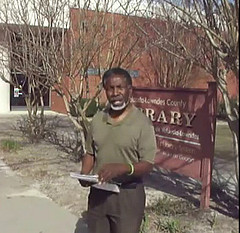The VDT has apparently decided the City of Valdosta is to blame for the Withlacoochee Wastewater Woes, and has made its case in a story and two editorials. They seem to have forgotten about the overflow in 2012 already. And the VDT seems to have forgotten about it and its editor's own apparent roles in the loss of the recent SPLOST election that would have funded a new wastewater plant.
Jason Schaefer wrote for the VDT today, Money saved at river's expense: EPD investigates cause of sewage release as waters recede,
When the flooding occurred in April 2009, the City made
extraordinary efforts to hold back the flooding, bringing in dirt and heavy machinery to build a berm around the influent pump station and other treatment equipment, working round the clock.
The efforts were successful. The treatment plant remained on during the duration of the flood, and Valdosta's raw sewage remained contained, though the facility incurred damages to its electrical and biological purification systems, according to Utilities Director Henry Hicks.
This year, the City opted for a different approach—cut electricity to the underwater portions of the plant, submit to the flooding and clean up afterwards.
The plant was “taken offline” Thursday at 9 a.m. “to prevent further damage to equipment and associated electrical and control systems,” according to a statement issued by the Department of the City Manager.
The City stated that as a result of the shutdown, “untreated sewage will be discharging directly into the river” at a rate of between five and six million gallons of raw sewage per day.
In addition, the floodwaters were allowed into the plant and around the remaining portions of the berm that was constructed in 2009 during the rising flood. Only half of the berm now remains, as the other half was removed to allow access to the lower portions of the plant, Hicks said.
So far, this year's response strategy seems to have saved the City money. In 2009, about $500,000 was spent in manpower, equipment and supplies to build the berm alone, and the plant, kept running, incurred significant damages though raw sewage was kept out of the river. This year, the money was not spent on the berm or to prevent the flooding, and at least 15 to 20 million gallons of raw sewage will have been released into the Withlacoochee by the time the plant is back online.
There's more in the story, which is well worth a read. Also note this inserted in the middle of the story:
Editor Kay Harris contributed to this story.
The VDT cites the EPA report, National Enforcement Initiative (FY 2011 – 2013) Keeping Raw Sewage and Contaminated Stormwater Out of Our Nation’s Waters, (more about that EPA initiative here) and continues:
Since the 2009 flood event, the city has applied three times to the Federal Emergency Management Agency for funding to make major improvements to the sewer system, move and rebuild the plant at a cost of more than $90 million. FEMA denied the city's requests each time.
At this time, the sewage discharge is also a potential risk to the city's drinking water supply. According to information provided by
the United States Geological Survey (USGS), the Upper Floridan aquifer is the sole source of water supply for Valdosta and much of the surrounding area. The aquifer “receives large volumes of direct discharge from the Withlacoochee River through sinkholes in the streambed or off-channel.”
The USPS states,”The strong connection between the Withlacoochee River and ground water in the Valdosta area has created concerns about the potential for contamination of groundwater supplies by contaminants in the river.”
VDT editorial 28 February 2013, Planning for ‘a little rain’ seems to refer to the VDT's effects of rain story of 25 February, and the editorial concludes:
A better plan may not have resolved the issues faced by the city and within the city this week, but better planning may have had officials and residents better prepared for an occasion when more than a little rain fell.
VDT editorial 2 March 2013, What’s worth more? concludes:
When questioned about the reasoning for not protecting the plant from flooding this time, the only answers have been about money. Perhaps if more of the plant is damaged now, FEMA will approve the funding to move and rebuild it. In the long run, the cost benefits of letting it flood and being able to replace it were weighed against environmental harm, and the river lost.
In four short years, dumping raw sewage went from a potential catastrophe to a barely noticed non-issue. In the long run, the community will have to decide if it was worth it.
 It's curious the VDT and its editor Kay Harris appear to put all
the blame for the wastewater woes on the City of Valdosta,
when the VDT and Ms. Harris were certainly involved in
the failed SPLOST VII election
that would have funded upgrades or replacement of the Withlacoochee Wasterwater
Treatment Plant.
It's true I haven't heard many city or county elected officials
acknowledge that
Houston County's strategy of publishing real lists and involving
the public in real hearings before the vote
may have contributed to Houston County's SPLOST winning handily in March 2012.
It's curious the VDT and its editor Kay Harris appear to put all
the blame for the wastewater woes on the City of Valdosta,
when the VDT and Ms. Harris were certainly involved in
the failed SPLOST VII election
that would have funded upgrades or replacement of the Withlacoochee Wasterwater
Treatment Plant.
It's true I haven't heard many city or county elected officials
acknowledge that
Houston County's strategy of publishing real lists and involving
the public in real hearings before the vote
may have contributed to Houston County's SPLOST winning handily in March 2012.
 I've certainly seen no acknowledgement by the VDT or Ms. Harris that
the shoddy treatment of citizen observers at the Library Board she chairs
is not helping any future SPLOST win, especially given that
the proposed new library and its funding and architect selection process
may well have contributed to the local SPLOST losing,
especially when combined with
continued tension over transparency.
I've certainly seen no acknowledgement by the VDT or Ms. Harris that
the shoddy treatment of citizen observers at the Library Board she chairs
is not helping any future SPLOST win, especially given that
the proposed new library and its funding and architect selection process
may well have contributed to the local SPLOST losing,
especially when combined with
continued tension over transparency.
How about a bit more planning by the VDT and Ms. Harris for public participation in planning for taxes to support local infrastructure?
-jsq
Short Link: